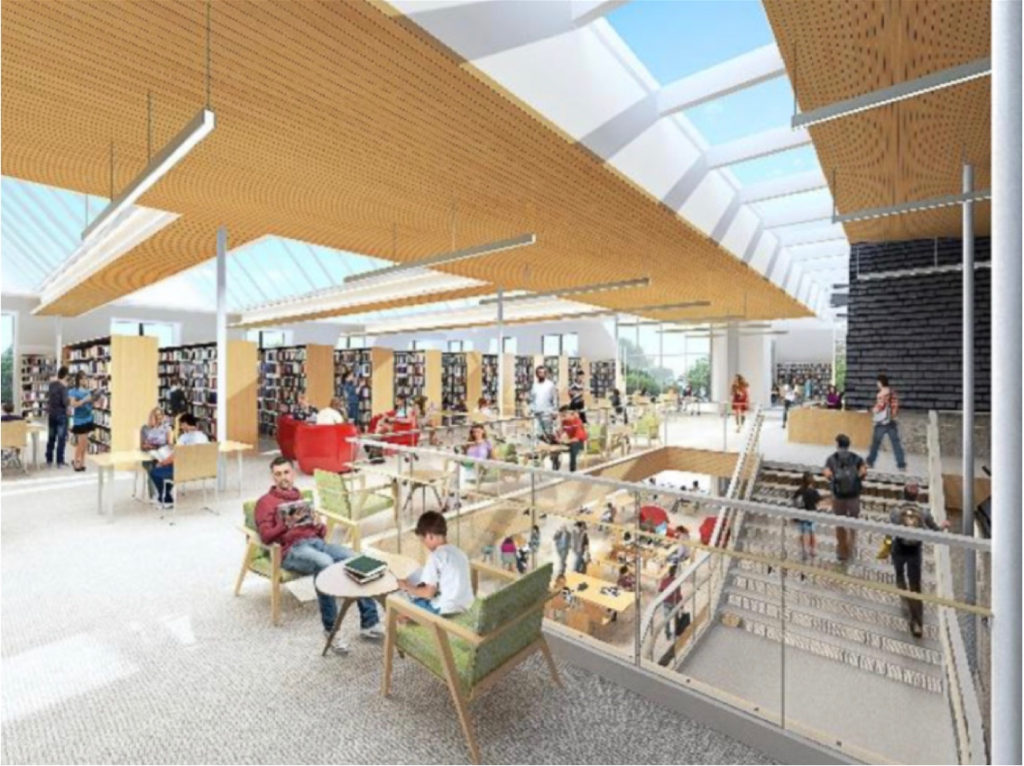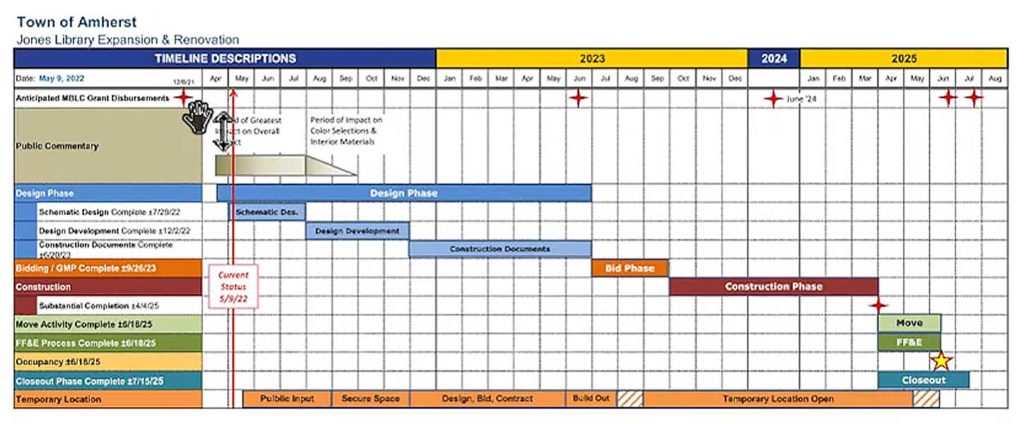Timber Construction For New Library Gets Thumbs Up

Interior rendering of proposed rennovated Jones Library adult collection area (second floor). Photo: Finegold Alexander Architects
Jones Library news highlights for the week of May 9, 2022
Building Committee Approves Expense Of Cross Laminated Timber Construction
The Jones Library Building Project has entered the early stage of the design phase during which public commentary is being gathered and final design decisions settled and communicated to Finegold Alexander Architects (FAA) before they develop a schematic design to go out to bid. FAA asked the Jones Library Building Committee (JLBC) for an early decision on whether the design should incorporate the sustainability feature of Cross Laminated Timber (CLT) construction.
A recent cost estimate predicts that CLT construction will add $506,000 to the cost of the library project compared to the use of standard steel and concrete construction which carries a high carbon footprint. FAA has explained that the design differences between timber and steel construction are significant, and the design would be expensive to change once a decision is made. At their May 10 meeting the JLBC discussed the pros and cons of utilizing CLT.
Todd Holland of the Jones Library Sustainability Committee described a method that has been used to compare CLT costs and benefits. He suggested looking at the societal cost of emitted carbon, estimated at $52 per metric ton by a study conducted during the Obama Administration. He referenced other estimates of carbon costs that range from $10 to $70 per metric ton. FAA has predicted that utilizing timber construction will prevent 118,704 kg of emitted carbon, or 118.7 metric tons. Using the $52 figure, this comes out to a societal cost savings of $6173. Holland pointed out that because CLT is more attractive, it would not need to be covered by ceiling tiles, representing some additional cost savings.
Speaking as a volunteer for the Vote Yes for the Jones Library referendum campaign and for the Capital Campaign, Ginny Hamilton emphasized that sustainability has been key in garnering public support and donations for the library project. “Taking [CLT] out now would have some pushback from folks in town who are proud of environmental features in the new building,” she said. She also brought up that the Capital Campaign has proposals out to funders who want to support sustainable capital projects.
Sean Mangano, declaring he was playing his role as Finance Director, cautioned that approving CLT now would mean harder cost-cutting decisions later. In a similar vein, Town Manager Paul Bockelman warned that the blunt reality of the economics of the project will require compromises. “I won’t say steel ourselves, but we need to cross laminate ourselves to be able to take these [hard decisions] on,” he said.
Library Facilities Supervisor George Hicks-Richards agreed that taking timber construction out of the design would be a big mistake. Trustee Alex Lefebvre and Jones Director Sharon Sharry also voiced strong support for CLT.
Sean Mangano, declaring he was playing his role as Finance Director, cautioned that approving CLT now would mean harder cost-cutting decisions later. In a similar vein, Town Manager Paul Bockelman warned that the blunt reality of the economics of the project will require compromises. “I won’t say steel ourselves, but we need to cross laminate ourselves to be able to take these [hard decisions] on,” he said.
These contrasting views prompted a question from Design Subcommittee Chair Christine Gray-Mullen. “If we say yes to this, what are other things that we may have to consider cutting?”
Owner’s Project Manager Craig DiCarlo listed several possibilities: changing the new building’s exterior envelope, revising the roof and skylight scheme in the current design, simplifying site improvement plans, reducing expenditure on fixtures, furnishings and equipment, and cutting back on other Energy Conservation Measures (ECMs). “So, there are other areas where costs could be reduced if needed,” he said.
Ultimately the committee voted to approve Cross Laminated Timber construction with six members voting in favor. Citing not enough information to make a definitive choice, Bockelman opposed the motion and Mangano abstained.
Amherst Historical Commission To Determine Fate of Kinsey Garden
On the agenda for the next meeting of the Amherst Historical Commission is the review of a proposal from Kestrel Land Trust to move selected plants from the David Chapin Kinsey Memorial Garden behind the Jones Library to Kestrel Trust Headquarters at 37 Bay Rd. in Amherst.
The proposal identifies and includes graphic images of more than 31 different trees, shrubs, and perennials that Kestrel aims to move, and adds that several stone benches and Goshen stones may find an appropriate home at the Bay Rd. site. It may not be feasible to move some of the larger trees, the proposal states.
The meeting packet includes a letter from Kinsey Garden creator Carol Pope thanking Kestrel Trust for its willingness to relocate the plants. Kestrel Trust representative Jane Bryden estimates that the relocation will cost approximately $10,000. The group plans to initiate a “Go Fund Me” campaign to raise funds for the operation.
In return for receiving Community Preservation Act funds for past chimney and roof repairs, the Jones Library Board of Trustees has entered into a Historical Preservation Restriction Agreement with the Town for the purpose of assuring that “the features and characteristics that embody the architectural, historic and cultural significance of the exterior of the Building will be forever retained and maintained substantially in their current condition and to prevent any use or change in the Property that will significantly impair or interfere with the Building’s preservation values.”
It will be up to the Amherst Historical Commission, acting on behalf of the Town of Amherst, to determine if the Jones Library building project’s plan to allow Kestrel Trust to move selected plants, and to demolish the remainder of the Kinsey Garden, complies with the terms of the Historical Preservation Restriction.
The Historical Commission meets on Wednesday, May 18 at 6:30 p.m. over Zoom.
Library Building Project Timeline as of May 9, 2022


Sadly, CLT is just another UMass hyped scam to continue business-as-usual in logging forests that should instead be left undisturbed to continue capturing CO2 emissions and storing carbon in this, the Climate Crisis. Furthermore, ask your local fire department what they think about the industry scheme to expand CLT, especially in high-rise construction. Industry and their followers’ party-line comeback is usually “What about the big carbon footprint of concrete construction??” but now there is masonry material that actually absorbs CO2. Building with wood is hopelessly old-school in these times of climate chaos and just more fire hazards in our midst. Just sayin’!
The lifetime for good concrete and steel construction can be many centuries – what about CLT?
The “embodied carbon” calculation may be missing the denominator: the lifetime of the building.
Of course, if new trustees and directors insist on demolishing/expanding every few decades, why not revert to a (very big) yurt?